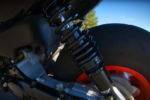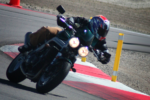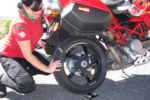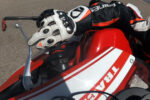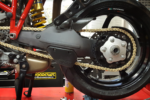Motorcyclists and cyclists have more in common than many of each group probably wants to admit, and as such there’s quite a bit of gear that translates between the two activities. One such item that has become one of our favorites is the Messenger Bag.
Ruck’s (or backback’s as us Yanks call ‘em) are miserable. Because your arms are reaching forward to the bars, the straps become the cause of discomfort, more discomfort the farther you have to travel. We make no concessions, we hate riding motorcycles with rucksacks on our backs. Because so many of the CanyonChasers also put thousands of miles a year on a bicycle it was only natural we’d give the bike courier’s best friends a go.
As far as we know, the messenger bags have been around since ancient times and were even used by the Pony Express riders of the Old West. The modern messenger bag came out of the De Martini Globe Canvas Company in Little Italy, New York who modified the concept to work for utility lineman so they could reach necessary tools while climbing utility poles. So while they are similar in function to backpacks, messenger bags specialize in the ability to carry heavy and bulky items while still allowing easy access to their contents.
Timbuk2 is probably the most familiar name in bike messenger bags established in 1989. They’re based out of San Francisco and it is one of the few remaining facilities operating in the city (although they also have manufacturing in Vietnam). The quality of their product is exceptional. Seams are robust, materials of a very high quality, and our most favorite bit is that you can go online and build your own bag, choosing from different materials, colors and extra features. Great fun. Since we happen to have scads of Italian bikes migrating their way into the CanyonChasers garages, we thought it only natural to choose colors representative of the Italian flag. How geeky are we?

It’s a traditional bag, as you’d expect, with one large strap that goes over one shoulder. Timbuk2 has fit a very large release strap that allows you to change the strap length quickly and easily. This is fantastic in the event that you’ve already put on your helmet and coat before putting on the bag. Loosen the strap and the bag will easily slip over the top of the helmet, pull the strap tighter and you can cinch the bag up tight. We found the shorter the strap the better things seemed to work, preventing the bag from resting on the tail section of the bike; not a problem if you run a back seat, but if you have a painted seat cover you probably want to be mindful of a bag rubbing on the delicate paint. We found the single strap much easier to put on than a backpack that requires you have sloppy/loose straps to get over the jacket shoulder armor, and can be so difficult to remove that you sometimes have to take your jacket off with the backpack.
To keep the bag from rotating around and working its way under your arms there’s a second security strap that wraps around the chest. This keeps the bag from flopping around as well as rotating out of place. For added visibility, the bag comes with some bright reflective straps that dangle from the bottom of the bag. Not only do they throw back plenty of light but the fact that they dangle makes them flap around a bit when you are riding along. The flapping motion of the retroreflective straps helps increase visibility since it tends to draw your eyes to the movement.
So how does this all work? Because the straps across the chest and over the top of the shoulder there is nothing to hinder your arms reaching forward. And because the bag tends to rest on the middle of your back, there is nothing pulling back and down on your shoulders. When properly situated, it’s quite easy to forget you are carrying a bag at all – something we’ve never discovered with backpacks. The only problem we ever had with comfort is if the back is heavily loaded and we aren’t too careful putting it on, the wide strap can sometimes rest on top of the collar-bone and cause some level of discomfort. But a quick shift of the bag alleviates this problem.

Finally, the ability to get in and out of the back quickly, without removing it, becomes a wonderful feature. Release the safety strap, loosen the main strap, and the bag will swing around to the front allowing you to get at the contents. The ability to quickly access ID cards, keys, folders or anything else without having to pull it off, drop to the floor and rummage became one of our favorite features. And if that’s not enough, there are scads of extras you can add to the bag, including cool cell-phone pouches, ID pouches and all sorts of do-dads to make the bag work better for you.
So how do these bags hold up? Impressively well. After almost two years of regular commuting, lugging laptops, and anything else we need to take with us and the bag still looks practically brand new! No seams have popped, no cloth has frayed, the colors have not faded nor stained after the rigors of use. Color us impressed.
If all you’ve ever used is a backpack, we feel you owe it to yourself to give a messenger bag a try. We don’t know anybody that tries a messenger bag who returns to using a backpack, and when its time to pick out a messenger bag, we give the Timbuk2 high marks.
For more information, check out Timbuk2.com
